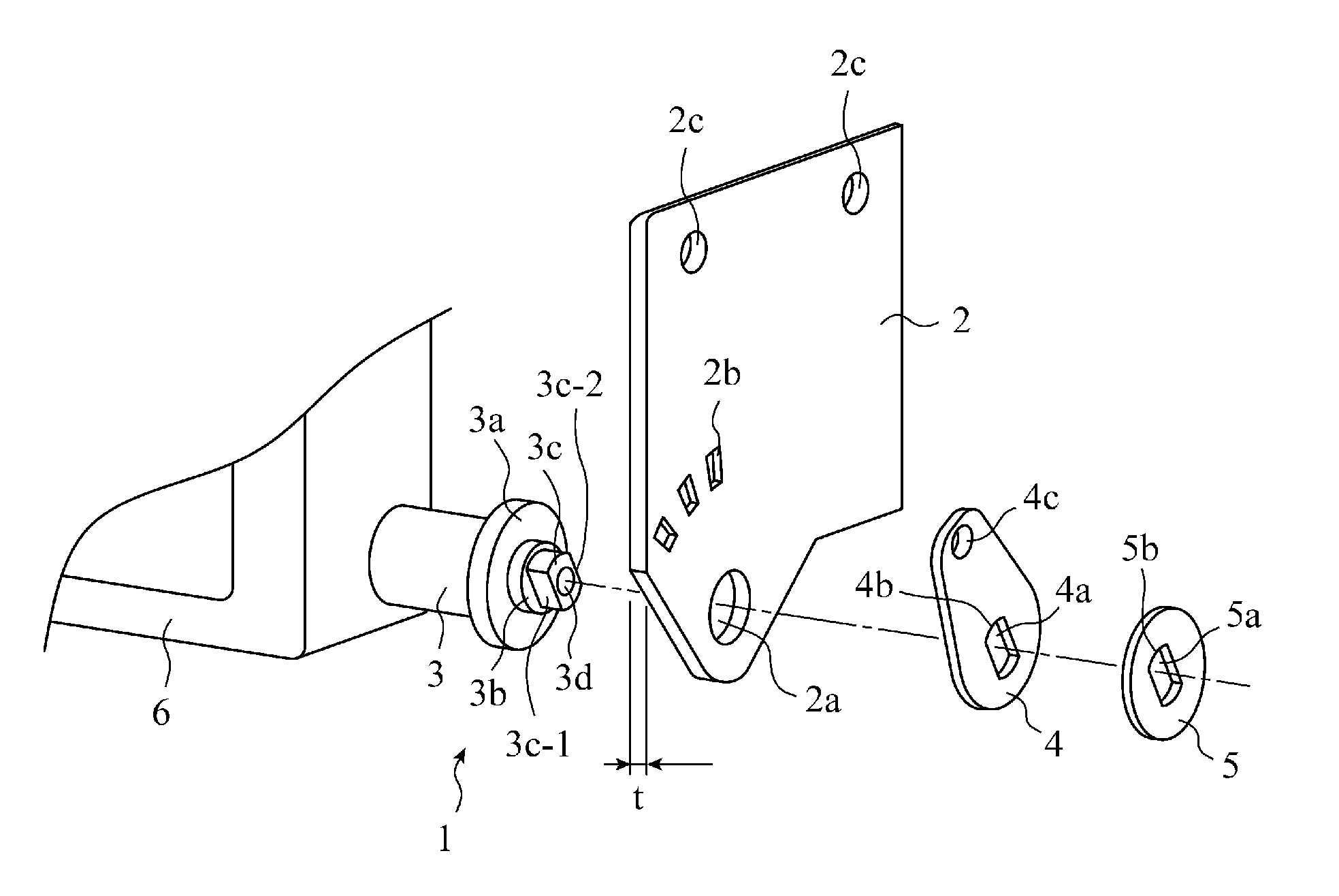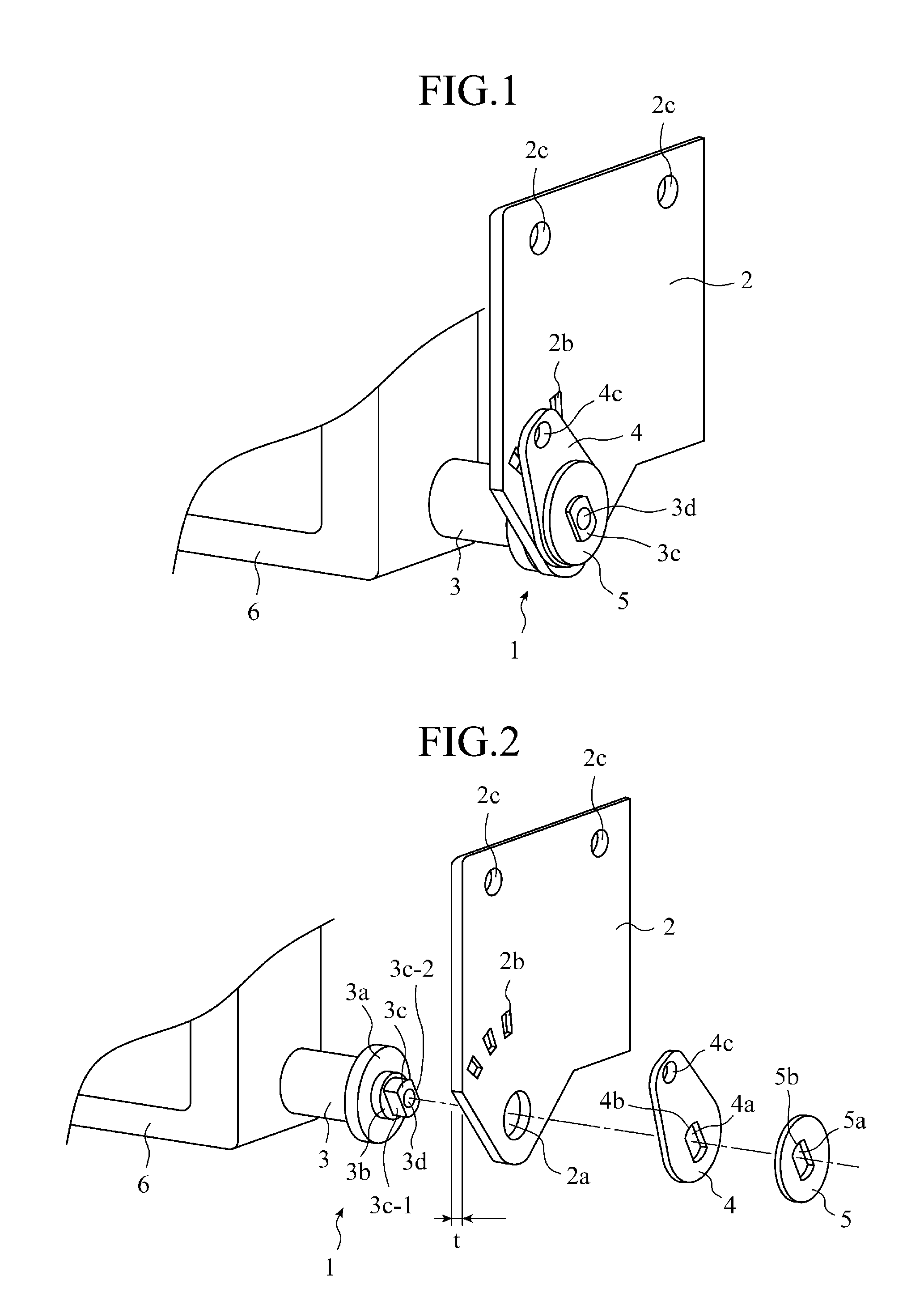Hinge mechanism
a mechanism and hinge technology, applied in the field of hinge mechanisms, can solve the problems of difficult adjustment of pressurization force, no judging method, and inability to confirm the thickness of the wing, and achieve the effect of reducing the noise between the leaf spring and the rotation shaft, and preventing abnormal nois
- Summary
- Abstract
- Description
- Claims
- Application Information
AI Technical Summary
Benefits of technology
Problems solved by technology
Method used
Image
Examples
first embodiment
[0019]The present invention will be explained by using as an example a case where a monitor as an openable and closable body is foldably and unfoldably mounted on a housing case (not shown) installed on a ceiling face of a vehicle. As shown in FIG. 1, a hinge mechanism 1 has a structure where a circular portion 3b working as a rotation shaft portion of a rotation shaft 3, which is caused to laterally project from the side of a monitor (openable and closably body) 6, is passed through a circular portion insertion hole (rotation shaft portion insertion hole) 2a of a bracket 2, a leaf spring 4 and a plate 5 are assembled to a non-circular portion 3c serving as a mounting shaft portion provided at the end of the circular portion 3b inserted through the circular portion insertion hole 2a, and the non-circular portion 3c is caulked to rotatably fix the rotation shaft 3 to the bracket 2.
[0020]The constituent members will now be explained in more detail with reference to FIG. 2 and FIG. 3. ...
second embodiment
[0029]A hinge mechanism in accordance with the second embodiment has a structure where the non-circular portion insertion hole 5a of the plate 5 is formed having a generally rectangular shape having a width (A+α) and a height (B+α), and having a small circular arc only at each of four corners as shown in FIG. 5. Therefore, the four corners each have formed therein a gap 5c-1 which is larger than the gap formed in the case shown in FIG. 3(d), and the deformed outer wall side part of the non-circular portion 3c of the rotation shaft 3, which has been collapsed by caulking, fits into the gaps in high amounts, thus enabling a larger caulking effect to be obtained. Moreover, forming the non-circular portion insertion hole 5a thereof so as to have a generally rectangular shape enables a die for forming the non-circular portion insertion hole to be easily built and maintained.
third embodiment
[0030]A hinge mechanism in accordance with the third embodiment has a structure where a sloping face 4d expanded or flared outwardly toward the plate 5 is formed such that a gap 7 is formed between the wall face of the non-circular portion insertion hole of the leaf spring 4 and the plate 5 as shown in FIG. 7. In the case, it is arranged that the non-circular portion insertion hole 4a of the leaf spring 4 and the non-circular portion insertion hole 5a of the plate 5 have the same diameter and shape of hole to each other, and that the non-circular portion insertion hole 4a and the non-circular portion insertion hole 5a have a shape which is slightly larger by the dimension of a fit than that of the non-circular portion 3c of the rotation shaft 3.
[0031]With this arrangement, when the non-circular portion 3c of the rotation shaft 3 is inserted through the non-circular portion insertion hole 4a of the leaf spring 4 and the non-circular portion insertion hole 5a of the plate 5 (FIG. 7 (a...
PUM
 Login to View More
Login to View More Abstract
Description
Claims
Application Information
 Login to View More
Login to View More - R&D
- Intellectual Property
- Life Sciences
- Materials
- Tech Scout
- Unparalleled Data Quality
- Higher Quality Content
- 60% Fewer Hallucinations
Browse by: Latest US Patents, China's latest patents, Technical Efficacy Thesaurus, Application Domain, Technology Topic, Popular Technical Reports.
© 2025 PatSnap. All rights reserved.Legal|Privacy policy|Modern Slavery Act Transparency Statement|Sitemap|About US| Contact US: help@patsnap.com



